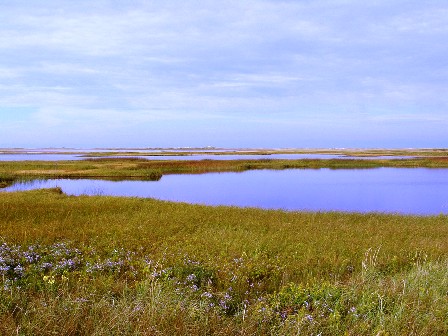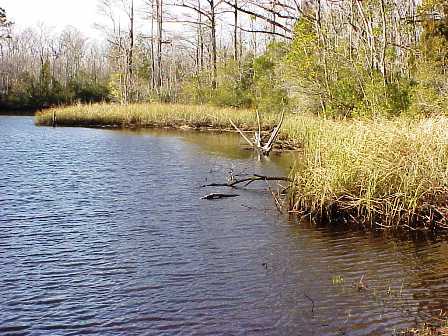Discover Florida Nature
It's time to explore the natural Florida


|
|
|
|
|
 Fresh
Water Marshes are part of the Freshwater Wetlands and Aquatic Ecosystem.
Florida has both the largest freshwater lake and the largest freshwater
spring (Wakulla Springs) in the contiguous United States. This makes
Florida a very rare state with a lot of aquatic diversity, from the
mangroves that prevent erosion to the swamps and marshes that naturally
filter our water. Most of the marshes in Florida occur south of Orlando.
Before the boom years of the early and mid 1900s, Freshwater marsh
habitats flourished along the St. Johns and Kissimmee Rivers and in
scattered spots in central Florida. Many of these sites are now gone or
severely altered, victims of development. Fresh
Water Marshes are part of the Freshwater Wetlands and Aquatic Ecosystem.
Florida has both the largest freshwater lake and the largest freshwater
spring (Wakulla Springs) in the contiguous United States. This makes
Florida a very rare state with a lot of aquatic diversity, from the
mangroves that prevent erosion to the swamps and marshes that naturally
filter our water. Most of the marshes in Florida occur south of Orlando.
Before the boom years of the early and mid 1900s, Freshwater marsh
habitats flourished along the St. Johns and Kissimmee Rivers and in
scattered spots in central Florida. Many of these sites are now gone or
severely altered, victims of development.
Throughout the southern part of the state small flatwoods marshes exist in the slight depressions commonly found in pine flatwoods. Ranging in size from less than one to occasionally more than ten acres, these habitats are seldom more than a foot deep during the peak time of the rainy season. SUBSTRATE: Peat in deep-water marshes with long hydro-periods; marl or sandy in marshes with moderate to short hydro-periods and seasonal drying.TOPOGRAPHY: Low, flat, poorly drained.. VEGETATION: Dominant species are herbaceous plants such as water lily, cattail, maidencane, and pickerelweed; most are of temperate origin; the Everglades marsh, which is by far the largest, is dominated by sawgrass. FAUNA: Abundant animal life, but not diverse, except for birds; both temperate and tropical birds abound; habitat for the endangered Cape Sable seaside sparrow, snail kite, and wood stork; the American alligator is an important animal in many Florida marshes; white-tailed deer use freshwater marshes extensively, along with the endangered Florida panther. PROCESSES / DYNAMICS / ABIOTIC FACTORS: Shallow water at or above the soil surface for much of the year; fire is of crucial importance in limiting invasion of woody vegetation; fire period in deep-water marshes is every 3-5 years; shallow marshes tend to burn on a 1-3 year cycle. NEGATIVE IMPACTS: Campaigns to drain wetlands throughout history of Florida following European settlement; between mid-1950's and mid-1970's, 24% of Florida's remaining marshes were drained; many more have been severely altered by unnatural flooding.  Freshwater
marshes are generally wetlands with an open expanse of grasses and other
grass-like plants. Freshwater marshes generally contain few, if any,
trees and shrubs. Marshes have standing water for much of the year and
act as natural filters. As water passes over the marsh, water flow is
slowed down, and suspended particles settle out. Like the state's
freshwater swamps, water levels fluctuate in the marshes. From June
through September daily rains the marshes have standing water. From
October to December of January, when the rainfall amounts are very low,
the standing water gradually flows towards the coast or seeps into the
porous ground. By February and continuing through the end of May, many
marshes are completely dry. This makes them susceptible to fires. Freshwater
marshes are generally wetlands with an open expanse of grasses and other
grass-like plants. Freshwater marshes generally contain few, if any,
trees and shrubs. Marshes have standing water for much of the year and
act as natural filters. As water passes over the marsh, water flow is
slowed down, and suspended particles settle out. Like the state's
freshwater swamps, water levels fluctuate in the marshes. From June
through September daily rains the marshes have standing water. From
October to December of January, when the rainfall amounts are very low,
the standing water gradually flows towards the coast or seeps into the
porous ground. By February and continuing through the end of May, many
marshes are completely dry. This makes them susceptible to fires.
Sawgrass is the most common marsh plant in Florida. It is the dominant plant of the Everglades. Other common plants include water lily and bladderwort in the deeper water marshes and cattail, spikerush, maidencane, arrowhead, bulrush, and cordgrass in the seasonally dry marshes. The largest freshwater marsh is the famous Everglades in the southeastern part of the state. Coined the River of Grass by the matriarch of the Everglades, Marjory Stoneman Douglas, the habitat is now considered on of the most imperiled in the country. Decades of attempts to drain the swamp and make it of some use to man has left the system in a dysfunctional state. No where is this more evident than in the bird population. Prior to the extensive channelization and installation of flood control structure, the Everglades were home to million of wading birds. Now the number is estimated to be less than 200,000. |
|
|
Advertise | Privacy Statement | Dog Encyclopedia | Video |Contact Alaska Nature| Michael Arnold Art |
|